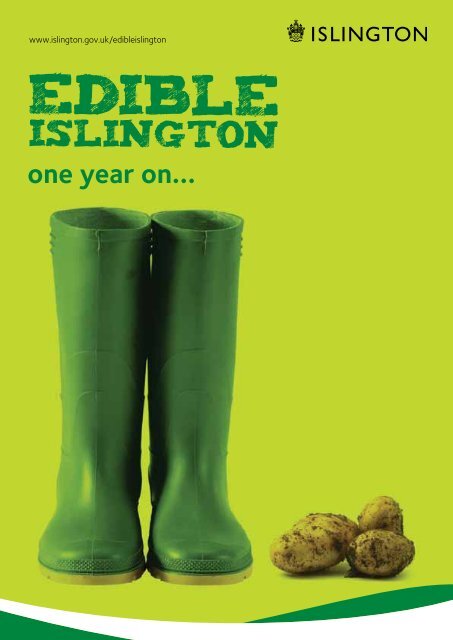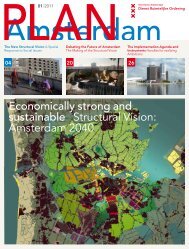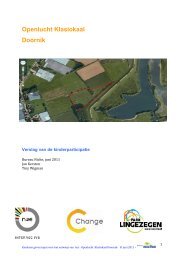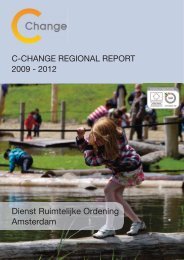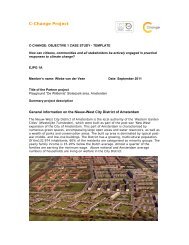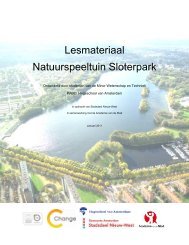one year on... - Islington Council
one year on... - Islington Council
one year on... - Islington Council
Create successful ePaper yourself
Turn your PDF publications into a flip-book with our unique Google optimized e-Paper software.
www.islingt<strong>on</strong>.gov.uk/edibleislingt<strong>on</strong><str<strong>on</strong>g><strong>on</strong>e</str<strong>on</strong>g> <str<strong>on</strong>g>year</str<strong>on</strong>g> <strong>on</strong>...1
<str<strong>on</strong>g><strong>on</strong>e</str<strong>on</strong>g> <str<strong>on</strong>g>year</str<strong>on</strong>g> <strong>on</strong>...One <str<strong>on</strong>g>year</str<strong>on</strong>g> after the launch of Edible Islingt<strong>on</strong>, Islingt<strong>on</strong> <strong>Council</strong>’s campaign forfood growing, we celebrate its success and recognise the hard work of themany growing groups by looking at the impact it has had <strong>on</strong> Islingt<strong>on</strong> and itscommunities.In 2009, Islingt<strong>on</strong> <strong>Council</strong> launched Edible Islingt<strong>on</strong>, a £1 milli<strong>on</strong> campaign tosupport local communities to grow their own food. The campaign aimed to developopportunities for food growing across the borough, supporting the producti<strong>on</strong> of,and access to, locally produced food and promoting social wellbeing, healthy livingand sustainability.Food is integral to all our daily lives and has huge social, ec<strong>on</strong>omic and envir<strong>on</strong>mentalimplicati<strong>on</strong>s. Community food growing is becoming increasingly popular andacknowledged as a fun and cheap way of producing healthy food. There is a hugeinterest in community food growing in Islingt<strong>on</strong>. However, being <str<strong>on</strong>g><strong>on</strong>e</str<strong>on</strong>g> of the boroughswith the least amount of open space, it has never been easy to find large open areasfor growing food. The Edible Islingt<strong>on</strong> campaign funded and supported over 100projects across Islingt<strong>on</strong> to grow their own fruit and vegetables. These sites includedhousing estates, schools, shared gardens, universities, parks and the creati<strong>on</strong> of anew allotment site for Islingt<strong>on</strong>.The project was delivered in partnership with Groundwork, St Luke’s Centre andCapital Growth. Community groups were able to apply for either a small grant (up to£3,000) or a large grant (up to £15,000) to set upand develop their food growing site. However, thecampaign was more than simply a grant scheme.In delivering Edible Islingt<strong>on</strong>, the council adopteda community development approach, supportinggroups not just financially but also to build theirknowledge and capacity. A range of groups -including those who didn’t have previous foodgrowing experience or who had never applied fora grant - were given the chance to develop a foodgrowing project. Small grants were administeredby Capital Growth and all those who receivedthese grants were supported by the CapitalGrowth scheme. Large grants were administeredby Groundwork and all those who made enquiriesregarding these grants were allocated a projectofficer from either Groundwork or St Luke’s Centreto visit the site, discuss ideas and help them withthe applicati<strong>on</strong> process.2
Those who received grants were allocated a project officer who worked with thegroup to build their capacity, run sessi<strong>on</strong>s etc. to ensure that their food growing sitesgot off to the best possible start and were sustainable in the l<strong>on</strong>g run. It was foundthat this <str<strong>on</strong>g><strong>on</strong>e</str<strong>on</strong>g> to <str<strong>on</strong>g><strong>on</strong>e</str<strong>on</strong>g> support provided by allocated project officers was integral to theprogramme’s success.One <str<strong>on</strong>g>year</str<strong>on</strong>g> after the launch of the campaign, we have looked at the impact thecampaign has had <strong>on</strong> Islingt<strong>on</strong> and its people. Although <str<strong>on</strong>g><strong>on</strong>e</str<strong>on</strong>g> <str<strong>on</strong>g>year</str<strong>on</strong>g> is a short timeperiod for any growing project, the results have been impressive with many positiveoutcomes. Projects that started out simply to grow fruit and vegetables for theircommunity have had many unexpected added benefits.These have included vast improvements to their local envir<strong>on</strong>ment, reducti<strong>on</strong> incrime and anti-social behaviour, development of a sense of community, support toelderly, vulnerable and disabled residents and development of pers<strong>on</strong>al skills andeducati<strong>on</strong>al opportunities for young people and adults.Through projects, stories and experiences, this report looks at the impact EdibleIslingt<strong>on</strong> has had <strong>on</strong> its community under five themes:• Improving space in Islingt<strong>on</strong>• Getting to know the community• Supporting disabled, elderly and vulnerable communities• Creating safer neighbourhoods• Engaging young peopleThe success of the Edible Islingt<strong>on</strong> campaign has depended <strong>on</strong> all the groups thathave worked hard to make their projects a success. Each project has its own uniquestory. This legacy report recognises and celebrates their efforts and successes bysharing a handful of these stories. The aim of the report is to share these successeswith all the Edible Islingt<strong>on</strong> groups and provide inspirati<strong>on</strong> to other groups that arethinking of starting their own food growing projects. The report also aims to highlightthat in additi<strong>on</strong> to having bumper harvests of home grown fruits, vegetables andherbs, food growing can have many benefits to both individuals and the communityas a whole.3
A summary of what has been achievedThis secti<strong>on</strong> briefly compares what Edible Islingt<strong>on</strong>initially set out to achieve with the project’s actualachievements.What did Edible Islingt<strong>on</strong>set out to achieve?(Objective)What has Edible Islingt<strong>on</strong> actually achieved?To increase the numberof food growing sitesacross the boroughEdible Islingt<strong>on</strong> helped set up over 100 food growing projects acrossIslingt<strong>on</strong>. These included:• a community allotment at Pollard Close with 27 new plots;• a large community garden at St Luke’s Community Centre;• 22 estate based projects which included social housing estates,housing estate garden sharing schemes and sheltered housing;• more than 25 community open space based projects whichincluded community centres, communal gardens, private gardensharing and orchards;• more than four food growing areas in parks;• three therapeutic gardens for the vulnerable and disabled;• 47 food growing sites in schools, nurseries and children’s centres;• two food growing projects in universities.In additi<strong>on</strong>, over 90% of these sites set up a rain water harvestingand/or composting system for the site to ensure resource efficiency.Resp<strong>on</strong>ses from our large grant recipients al<str<strong>on</strong>g><strong>on</strong>e</str<strong>on</strong>g> estimated that4,767m 2 of land had been improved through the projects. This islikely to be a massive underestimate as 41 more projects were set upthrough small grants.See appendix A for a list of Edible Islingt<strong>on</strong> projects.To increase the numberof residents engaged infood growing throughcommunity engagementIt is estimated that over 5,000 residents have been engaged in foodgrowing through the Edible Islingt<strong>on</strong> project.Detailed data available for the large grant projects estimate that3,070 people were engaged in just these 64 projects. Of these,2,162 were said to be young people.Engagement was well represented across all ethnicity groupsincluding white, black/Caribbean, Chinese, Asian, mixed andother groups. However these numbers are likely to be highlyunderestimated as many projects were unable to estimate thenumbers their project had engaged and several reported that therewere “too many to count”.4
What did Edible Islingt<strong>on</strong>set out to achieve?(Objective)What has Edible Islingt<strong>on</strong> actually achieved?To enable schools toestablish their own foodgrowing programmeslinked to the nati<strong>on</strong>alcurriculum and healthyschools initiative41 schools have been supported to establish their own food growingprogrammes through either large or small grants. These schools haveintegrated their growing work into their curriculum through varioussubjects and clubs including gardening, art, mathematics etc.In additi<strong>on</strong>, six nurseries/childcare providers, three children’s centres,two universities and <str<strong>on</strong>g><strong>on</strong>e</str<strong>on</strong>g> college have also been supported to establishtheir food growing programmes. The Garden Classroom,an educati<strong>on</strong>al programme funded through Edible Islingt<strong>on</strong>,supported three schools over several m<strong>on</strong>ths to do more foodgrowing and helped staff and children to integrate food growing intotheir work programme.In additi<strong>on</strong>, an Edible Islingt<strong>on</strong> project run by Global Generati<strong>on</strong>,an organisati<strong>on</strong> that supports young people to play a part in creatinga sustainable future, engaged a large number of children fromschools, housing estates and hostels for the homeless in a foodgrowing project.To establish a c<strong>on</strong>tinuingprogramme of foodgrowing support andresourcing promotingnetworking and skillssharing, ensuring l<strong>on</strong>gterm sustainabilityand legacyWe are immensely proud of what the Edible Islingt<strong>on</strong> projects haveachieved through the hard work, enthusiasm and commitment ofthe many groups involved. Although the funding has closed, we arekeen to ensure that the food growing projects set up c<strong>on</strong>tinue to run,yielding a bumper harvest <str<strong>on</strong>g>year</str<strong>on</strong>g> <strong>on</strong> <str<strong>on</strong>g>year</str<strong>on</strong>g> and providing many hours offun and enjoyment.The Edible Islingt<strong>on</strong> Networking event held <strong>on</strong> 17 March 2011by Capital Growth, in partnership with Edible Islingt<strong>on</strong>, providedan opportunity for Edible Islingt<strong>on</strong> groups to network and attendworkshops <strong>on</strong> food growing issues. In additi<strong>on</strong>, a number of toolshave been set up for Edible Islingt<strong>on</strong> groups to use for networkingand sharing skills, which we hope will ensure l<strong>on</strong>g term sustainabilityfor the project. These include the Islingt<strong>on</strong> Master GardenersProgramme, a map of Edible Islingt<strong>on</strong> sites and an Edible Islingt<str<strong>on</strong>g><strong>on</strong>e</str<strong>on</strong>g>-platform <strong>on</strong> the ‘Project Dirt’ website, for groups to communicatewith each other. More informati<strong>on</strong> <strong>on</strong> these and other supportavailable is outlined at the end of this report.By working in partnership with several projects and organisati<strong>on</strong>sincluding Capital Growth, Groundwork, St Luke’s Centre and manyother local organisati<strong>on</strong>s, we have strived to ensure that Islingt<strong>on</strong>is part of, and fits in with, wider food growing programmes acrossL<strong>on</strong>d<strong>on</strong>.5
Improving space in Islingt<strong>on</strong>High quality open space is an essential part of a desirable place to live. Islingt<strong>on</strong> has thesec<strong>on</strong>d lowest amount of open space of any Local Authority in the country. As a small butdensely populated borough, open space is highly valued but under increasing pressure.Several Edible Islingt<strong>on</strong> projects have successfully restored under-utilised, often derelictspaces by c<strong>on</strong>verting them into thriving food growing spaces. This secti<strong>on</strong> shares ahandful of these stories.# 1 Penn RoadThe impact of food growingThis secti<strong>on</strong> looks at the impact Edible Islingt<strong>on</strong> hashad <strong>on</strong> Islingt<strong>on</strong> and its communities throughanecdotes and stories shared by the projects.#1 (Number One) Penn Road is a small block of social housing flats with eight homes. A few <str<strong>on</strong>g>year</str<strong>on</strong>g>sago, <str<strong>on</strong>g><strong>on</strong>e</str<strong>on</strong>g> of the residents of #1, a keen gardener, set about transforming the large surroundinggardens through imaginative planting and a lot of hard work. The results received a lot of attenti<strong>on</strong>from the residents of the flats as well as the street. After the keen gardener moved <strong>on</strong>, a numberof the remaining residents took over the maintenance and subsequently started to grow theirown vegetables. However, resources were limited and they could <strong>on</strong>ly create a limited number ofgrowing areas using single boards. With some assistance from the Penn Road Residents Associati<strong>on</strong>,the residents of #1 applied for, and were then overjoyed to receive, an Edible Islingt<strong>on</strong> grant. Theybought a new greenhouse, proper raised beds, a shed and tools, and followed their proposed planto improve and increase the food growing beds. This made maximum use of available space forefficient food producti<strong>on</strong>, which resulted in producing a bumper harvest for them. At the sametime, an outdoor study area was created and is now used by all the children in the flats. As a resultof this project, the garden has been transformed into a thriving food growing area and they arelooking forward to the <str<strong>on</strong>g>year</str<strong>on</strong>g>s of growing ahead.BeforeAfter“...”“This project has been great. It has saved us so much m<str<strong>on</strong>g><strong>on</strong>e</str<strong>on</strong>g>y as we can just come and pick ourThis has been a fantastic project for all of us at #1, as we watched the vegetables grow beforeour very eyes, then enjoy them. They are so much more delicious knowing they are fresh andwholesome and more important that we grew them. We’ve not <strong>on</strong>ly enjoyed the planning andbuilding, the planting and the eating, but also learnt book keeping and project m<strong>on</strong>itoring.Jacqui, #1 residentvegetables from the garden. We’ve now got a great base to keep this going for <str<strong>on</strong>g>year</str<strong>on</strong>g>s to come.Darren, #1 residentFor further informati<strong>on</strong> c<strong>on</strong>tact: chair@pennroadn7.co.uk...”6
Ringcross Community CentreRingcross Community Centre managed by Hyde HousingAssociati<strong>on</strong> is located <strong>on</strong> Ringcross Estate and hosts anumber of activities for the local community. Since Aprillast <str<strong>on</strong>g>year</str<strong>on</strong>g> volunteer gardeners from the Ringcross areahave been busy clearing, sowing, planting in, compostingand watering to grow as much as possible at the back ofthe Ringcross Community Centre. Some of the produceharvested last seas<strong>on</strong> included carrots, beetroot,potatoes, radishes and runner beans, not to menti<strong>on</strong>pumpkins. As a result the volunteers have successfullyc<strong>on</strong>verted an unused, derelict piece of land at the backof the building into a flourishing, well designed foodgrowing space.BeforeBeforeAfterAfter“Ventures like this are a really great way to meet people and improve our envir<strong>on</strong>ment.The gardening work is always worth it when you see the results and the commentsfrom residents and visitors have been really positive.Richard, head volunteerFor further informati<strong>on</strong> c<strong>on</strong>tact: rxcc@hyde-housing.co.uk...”7
Halt<strong>on</strong> Mansi<strong>on</strong>s Communal GardensThe Halt<strong>on</strong> Mansi<strong>on</strong>s Garden Group have successfully transformed an under utilised communalgarden space into a productive food growing area. The transformati<strong>on</strong> of the space has been wellreceived by local residents.BeforeAfter“I never in a milli<strong>on</strong> <str<strong>on</strong>g>year</str<strong>on</strong>g>s thought I would end up making spinach soup with spinach frommy own garden, but it has happened! The whole thing has been - and still is - a greatexperience. Not <strong>on</strong>ly are we learning about gardening but we’re also spending more timeoutside, using the space we’d never used in the past, and talking to neighbours, someof whom we didn’t even know before all of this. C<strong>on</strong>sidering our previous neighbourlyinvolvement was about going to court to try and close down a crack den, this is a huge”improvement and a source of pleasure <strong>on</strong> a daily basis.Danka, ResidentFor further informati<strong>on</strong> c<strong>on</strong>tact: agentn1@btinternet.comPermanent allotment, Pollard Close“AfterA permanent allotment was created byc<strong>on</strong>verting an unused car park and dumpingground at Pollard Close into a food growingspace with 27 plots and two accessiblecommunity planters. All plots were let toIslingt<strong>on</strong> residents <strong>on</strong> the allotment waiting list.The site includes a full rain water harvestingsystem and all water used is rain water.Electricity for the site is solar generated andthere is a fully accessible composting toilet <strong>on</strong>site. The plot holders have created the PollardClose Allotmenteers Group.With such a l<strong>on</strong>g waiting list for allotments, the plot holders are delighted to have had thisnew space created to grow their own fruit and vegetables. We are happy to have put thisunused space to such good use and hope that the Pollard Close Allotmenteers Group will”help the allotment to grow from strength to strength.Jerry Gutwin, Performance and Improvement Manager, Greenspace ServiceFor further informati<strong>on</strong> c<strong>on</strong>tact: jerry.gutwin@islingt<strong>on</strong>.gov.uk8
City University L<strong>on</strong>d<strong>on</strong>The staff and students of City University L<strong>on</strong>d<strong>on</strong> have c<strong>on</strong>verted a small derelict area of paved land<strong>on</strong> their Northampt<strong>on</strong> Square Campus into a food growing site. The area was cleared and raisedbeds installed growing a variety of vegetables and herbs.BeforeSetting it upAfterAfter“This was a derelict bit of space full of rubbish and underused. Now we can come down in thesummer and do some gardening in our lunch hour. We also sometimes have our lunch outhere. We had a bumper crop of tomatoes this <str<strong>on</strong>g>year</str<strong>on</strong>g> and potatoes. We hope we can plan aheadthis <str<strong>on</strong>g>year</str<strong>on</strong>g> and get some good crops that we could perhaps sell in our food co-op....”Hannah, staff memberFor further informati<strong>on</strong> c<strong>on</strong>tact: H.Lewis-2@city.ac.uk9
Getting to know the communityAlthough living in densely populated urban areas we often find that we know very littleabout the community we live in and rarely know our neighbours. The Edible Islingt<strong>on</strong>project has shown that food growing is an ideal catalyst for developing community spirit.A closer neighbourhood, the Three Sisters Project, Islingt<strong>on</strong>““The Three Sisters Project, a system of compani<strong>on</strong> growing of sweetcorn, runner beans, squashand nasturtiums was started by Islingt<strong>on</strong> Gardeners to encourage houses with limited space tostart food growing in ‘grow bags’. The project was spread across Islingt<strong>on</strong> with the largest clusterof 50 participants in the Ambler Road area. The project which started as an educati<strong>on</strong>al project todem<strong>on</strong>strate the importance of urban food growing by using space creatively, ultimately resultedin the creati<strong>on</strong> of a community hub that got to know each other working together to improve theirlocal area.Neighbours worked together to help the less able with their fr<strong>on</strong>t gardens, to weed, plant,cut hedges and clear rubbish. Friendships blossomed with the flowers, and the effect has...”been to create a closer, happier, safer community, in which neighbours know each other.Naomi, resident, Ambler RoadA lady knocked <strong>on</strong> my door saying that she was from a house down the road, that she hadbeen locked out and needed some m<str<strong>on</strong>g><strong>on</strong>e</str<strong>on</strong>g>y. I asked her the house number and when shesaid it, I immediately suspected she might be a fraudster because I knew the householdersthrough the Three Sisters project and I knew that this lady did not live where she said. WhenI questi<str<strong>on</strong>g><strong>on</strong>e</str<strong>on</strong>g>d her further she quickly walked away. We now know most of our neighbours as aresult of our growing project....”Nicolette, resident, Plimsoll RoadFor further informati<strong>on</strong> c<strong>on</strong>tact: manitou@bluey<strong>on</strong>der.co.ukThe community food growing corner, Fortune Street ParkFortune Street Park is a small park located off Fortune Street and surrounded by housing estates.The park is popular am<strong>on</strong>gst both children and adults, particularly the elderly. Friends of FortuneStreet have very successfully c<strong>on</strong>verted a corner of the park in to a <str<strong>on</strong>g>year</str<strong>on</strong>g> round community growingplot managed by local residents. The locals often work <strong>on</strong> the plot in their free time, particularlyover the weekend. This project has helped to effectively engage the local community.“I often come down expecting to spend a few minutes weeding and doing odd jobs in the plotbut end up having to spend a lot of time talking to passersby who always stop to ask aboutthe vegetable plot. The plot has added uniqueness to this park and encouraged more...”of thelocals to be actively involved in and to use the park.Patrick, resident10
Residents had enjoyed a fine harvest of fruit and vegetables overthe summer. “All the produce was distributed for free and it hadhelpedrdevelop a sense of neighbourliness in the area”.The project has also resulted in drawing the attenti<strong>on</strong> of localbusinesses who have subsequently got involved.“...”“We are very pleased to get our families involved in the Community Garden, and offerour campus for their meetings. We know how vitally important the park is to the localcommunity, a high percentage of the families living in flats have no outdoor space to growthings or play. Understanding how things grow, how to look after them, where they comefrom and what they taste like, promotes healthy lifestyles and offers a different...”aspect tothe park which is unique to the borough of Islingt<strong>on</strong>.Jacqui, Community Development Worker, Golden Lane CampusThe business owner who overlooks the plot thought it was a reallygreat idea and d<strong>on</strong>ated climbers to grow al<strong>on</strong>g <str<strong>on</strong>g><strong>on</strong>e</str<strong>on</strong>g> wall. His staff isnow managing all the climbers. Another business owner has offeredhis warehouse to collect and store deliveries etc until the weekendwhen most members in the community can work <strong>on</strong> the garden.Sim<strong>on</strong>, residentThe project is supported by the Golden Lane Campus.For further informati<strong>on</strong> c<strong>on</strong>tact: friendsfortunepark@mac.comJust ask a neighbour, Aubert CourtAubert Court is a large block of social housing with over 600 residents. There was previously nospace for gardening and through the Edible Islingt<strong>on</strong> project they have now set up several raisedbeds for communal food growing.“A resident at Aubert Court wanted to garden but had no outdoor space <strong>on</strong> his sixth floor flat.So he approached the residents of a ground floor flat who did have a fr<strong>on</strong>t garden, althoughgiven the state of it they clearly didn’t have much of a green thumb! He asked if they wouldmind if he used their garden to grow vegetables and herbs. They were happy for him to doit, and the result was a flourishing vegetable patch, which got lots of residents enthusiasticabout having their own space to grow produce too. It was <str<strong>on</strong>g><strong>on</strong>e</str<strong>on</strong>g> of the motivati<strong>on</strong>s for puttingin our Edible Islingt<strong>on</strong> bid, and we are delighted with the raised garden beds we now...”have.Andrew, residentResidents from many backgrounds now come together to grow vegetables, herbs and fruits in thecommunal garden.For further informati<strong>on</strong> c<strong>on</strong>tact: andrew@fdc<strong>on</strong>sult.co.uk11
Overcoming trauma through food growing, Room2HealRoom2Heal is a community thatsupports victims of human rightsviolati<strong>on</strong>s in their lengthy anddifficult journeys towards a senseof pers<strong>on</strong>al safety, bel<strong>on</strong>gingand fulfilment.Edible Islingt<strong>on</strong> helped Room2Healset-up a therapeutic food growingspace with a variety of vegetablesand herbs. The garden bringsmembers together, providing,through food growing, a spacefor gaining skills, relaxing andsocialising, a key part oftheir therapy.Members designed and set up the plot themselves making key decisi<strong>on</strong>s as a group <strong>on</strong> layout,plants to grow and tilling the soil. The process has helped them to learn gardening skills andimportantly to work in unis<strong>on</strong>.“The prospect of growing healthy food has been str<strong>on</strong>gly welcomed by our members andprovided further opportunities for our members to enjoy fellowship with each other andwith local residents, as well as a site for cooking and sharing a meal....”Mark, Room2Heal staff memberMembers use the garden as a space for remembering their past and preparing themselvesfor their future.“It is more than just about gardening for our community. It is their therapy. It is wherethey can dig their hands in to the dirt and interact with other people. One of the userssaid that this bit of garden is his land – the <strong>on</strong>ly land that he now has. Many of the usersplant trees, flowers and bushes in memory of lost family members. Food growing also...”represents a bit of the rural life that was part of their past. It really helps them.Mark, Room2Heal staff memberAs a result of being involved in the Edible Islingt<strong>on</strong> project, some of the members are gettingmore widely involved with other activities in Culpeper garden and volunteer <strong>on</strong> other projects.Room2Heal therefore hopes that a group of skilled volunteers who are willing and able tospearhead a new food growing project <strong>on</strong> another site will emerge.For further informati<strong>on</strong> c<strong>on</strong>tact: mark.fish@room2heal.org.uk13
Food growing for older people, Cope House, Epic TrustCope House is a large sheltered housing scheme for 47 older people from a diverse range of culturaland social backgrounds, some of whom have complex support needs. The internal design of thescheme has always made it difficult to build a sense of community between residents; the EdibleIslingt<strong>on</strong> project is helping to achieve this.Four raised beds and a new bench were installed in the communal gardens of Cope House. Withinhours of the raised beds being built and installed resident had started to use them – the enthusiasmof those residents who got involved is really encouraging.“Food growing is a great way for us to get active. It makes people happy. I was knocking <strong>on</strong>doors and encouraging people to join in the gardening. Gardening is a nice way to get toknow each other as we d<strong>on</strong>’t all speak the same language. There is <str<strong>on</strong>g><strong>on</strong>e</str<strong>on</strong>g> lady who can’t comeout of her flat. But she gives instructi<strong>on</strong>s to her niece <strong>on</strong> what to do in her garden and weall help out. I myself really enjoy gardening with my husband. I took the Master Gardeners...”course which was just great. I hope we can get more residents involved in our gardening.Stella, Cope House residentAs the project has been so popular, Epic Trust has now hired a volunteer to support the residents ofCope House to expand <strong>on</strong> the Edible Islingt<strong>on</strong> project and get more residents involved in growingfood and using their communal garden.For further informati<strong>on</strong> c<strong>on</strong>tact: sue.wardell@circleanglia.org14
The Natural Growth Project, Freedom from TortureFreedom from Torture, formerly the MedicalFoundati<strong>on</strong> for the Care of Victims of Torture,helps survivors of torture from all over theworld who are so damaged that they are notready for even the most specialised, in-depthpsychotherapy. The Natural Growth projectuses the power of nature to bring people backfrom the brink of mental disintegrati<strong>on</strong>.The Edible Islingt<strong>on</strong> project helped introduceraised herb and vegetable beds that areaccessible to disabled clients and a greenhouseto help growing at higher temperatures whilstkeeping those clients who may be in frailhealth more comfortable.“Access to edible plants both indigenous and n<strong>on</strong> indigenous, supports an individual’sc<strong>on</strong>necti<strong>on</strong> with their past. We can grow plants originating from their homeland and nurture anunderstanding, a way of coping with their new envir<strong>on</strong>ment as they become familiar with theBritish climate and what can grow here. Also, in instances where plants from foreign soil fail to...”grow, it can support a client who is beginning to address issues of loss and very painful memories.Charlotte, staff memberAs part of the project, the group has c<strong>on</strong>structed a ‘Path of Life – from Edible to the Inedible’ whichallows visiting clients to reflect up<strong>on</strong> the journeys they have undertaken. Edible and sweet smellingplants, such as herbs, aloe vera and berries represent the positive aspects of their experienceswhilst prickly inedible plants and items such as cacti and boulders signify the more painful andchallenging elements of their passage thus far.For further informati<strong>on</strong> c<strong>on</strong>tact: CLock@torturecare.org.ukDid you know?The therapeutic effects of food growingThe therapeutic effects of gardening are widely accepted and many studies have shown thatgrowing <str<strong>on</strong>g><strong>on</strong>e</str<strong>on</strong>g>’s own food in particular has numerous benefits for those suffering from bothphysical and mental disabilities. Food growing encourages growers to eat a healthier dietrich in fruit and vegetables they have grown. Fresh air and exercise benefits muscles, b<str<strong>on</strong>g><strong>on</strong>e</str<strong>on</strong>g>s,the respiratory and the cardiac systems which in turn improves physical strength, flexibilityand endurance and reduces the risks of diseases such as heart disease, diabetes, obesity andosteoporosis.Food growing also helps to develop social and intellectual skills which help improve socialinclusi<strong>on</strong>, rehabilitati<strong>on</strong>, literacy and numeracy skills. It also provides a calm envir<strong>on</strong>ment thatpaves the path for relaxati<strong>on</strong> and calming the mind which has special benefits for those withmental health problems.15
Reducing anti-social behaviourResidents regularly tell the council and the police about their c<strong>on</strong>cerns regarding antisocialbehaviour. We are delighted that the establishments of several Edible Islingt<strong>on</strong>projects have resulted in the reducti<strong>on</strong> of anti-social behaviour in their local area.A safer Isled<strong>on</strong> Village, Parkside Growing PlotThe Parkside Growing Plot was a derelict piece ofwaste ground (former ecology enclosure) which wasc<strong>on</strong>verted in to a community food growing area. Itwas a hot-spot for anti-social behaviour and wasoften used by drug users. Planters were set up and theresidents in partnership with Circle 33 Housing Trusthave successfully c<strong>on</strong>verted this former derelict spacein to a flourishing vegetable patch. Food grown bytenants was used for the estate BBQ in the summer.Many events including an annual barbeque are held.A nature trail is now being developed <strong>on</strong> the land behind the growing plot, with the help of theland owners Origin Housing, for the local children in partnership with the Sam Morris Nursery andM<strong>on</strong>tem School. The establishment of this food growing space has been successful in deterringdrug users from the site and reducing anti-social behaviour.“I live opposite the site and all the anti-social behaviour and drug users hanging around inthe plot used to really bother me. The creating of this food growing area is the best...”thingwe have d<str<strong>on</strong>g><strong>on</strong>e</str<strong>on</strong>g>.Maria, residentThe project has also had other added benefits:“One resident who has disabilities has really enjoyed growing the vegetables at home andat the communal garden. He has sent a thank you email and photos thanking me for theproject and saying how much he enjoys it and how it gives him a reas<strong>on</strong> for leaving hishome and how he has met lots of new neighbours. He is now having some extra <str<strong>on</strong>g><strong>on</strong>e</str<strong>on</strong>g> to<str<strong>on</strong>g><strong>on</strong>e</str<strong>on</strong>g> sessi<strong>on</strong>s with the Groundwork gardener.Maria, resident”The Parkside Growing Plot has helped build the community spirit <strong>on</strong> the estate by involving many tenants,young and old, and has helped them to cement links with other local organisati<strong>on</strong>s. The Parkside GrowingPlot w<strong>on</strong> first prize in Capital Growth’s Edible Estates competiti<strong>on</strong> in October last <str<strong>on</strong>g>year</str<strong>on</strong>g> and this has givenevery<str<strong>on</strong>g><strong>on</strong>e</str<strong>on</strong>g> involved a real sense of achievement and a lot of hope for the future.For further informati<strong>on</strong> c<strong>on</strong>tact: maria.panteli@hotmail.co.uk16
Making Holly Park Estate safer, Holly Park community garden“Holly Park community garden located <strong>on</strong> Holly Park Estate was <strong>on</strong> a site that was unkempt andunused except by dog walkers who did not clear up, loud drinkers late at night and young drugusers. The garden has been now c<strong>on</strong>verted in to a fully cultivated well kept food growing site thatis well lit at night keeping undesirable activity away.We found a lot of old needles when we cleared the site. It was also an area through whichpeople evaded the police. They would run in and climb over the adjoining railings in thebushes and out in to Crouch Hill train stati<strong>on</strong>s. All this anti-social behaviour has now”reduced. This could be either due to a respect of the area or the fear that wr<strong>on</strong>gdoingin the cultivated site would not be tolerated.Jeannette, Chair, Holly Park Gardening ClubFor further informati<strong>on</strong> c<strong>on</strong>tact: jeanne88e@hotmail.co.ukReducing anti-social behaviour, Girdlest<str<strong>on</strong>g><strong>on</strong>e</str<strong>on</strong>g> EstateGirdlest<str<strong>on</strong>g><strong>on</strong>e</str<strong>on</strong>g> Estate, located in North Islingt<strong>on</strong>, is a social housing estate managed by Homes forIslingt<strong>on</strong>. The Girdlest<str<strong>on</strong>g><strong>on</strong>e</str<strong>on</strong>g> Gardening Club has successfully c<strong>on</strong>verted a derelict former playgroundin to a thriving community food growing space for residents and local community. The project hasreduced anti-social behaviour around the site.17
““One late summer evening I needed to do some work at the Community Centre office. Onthe way there I passed a group of about 5-6 hoodie-type youths, mixed racial backgrounds,aged 17-20ish smoking and mumbling am<strong>on</strong>g themselves. As I d<strong>on</strong>’t have ‘victim’ mentalityI did not feel threatened but could see that some would. On leaving the office 20 minuteslater, the same group was huddled at the vegetable plot gates pushing <strong>on</strong> the chain and thegate. I went up to them and asked if they’d like to know what we’re doing in there - theywere silent, transfixed probably by my different reacti<strong>on</strong> to them. Without waiting for ananswer I told them about the growing scheme and invited them to join us, pointing to theposter i’d stuck to the railing. They mumbled ‘yeah, ‘great, thanks’ still in shock. About aweek later, <str<strong>on</strong>g><strong>on</strong>e</str<strong>on</strong>g> of them came over just as we were locking up. He said he’d told his mumabout the organic veg we’re growing and she’d sent him back to ask if they could buy someand how much it was. I explained there was no cost - they were welcome to come and helpand the harvest is shared between all. He had trouble taking it in, but eventually got it andleft smiling with a spring in his step. Those lads have never been seen hanging around thatarea since.On another occasi<strong>on</strong> I’d seen this 10 <str<strong>on</strong>g>year</str<strong>on</strong>g> old boy with a small gang a few times, <strong>on</strong>ce <strong>on</strong> topof a bin shed throwing things and being generally naughty. I’d also been told the gang had lita fire <strong>on</strong> a bin shed. .Once when we were in the veg plot, including other children, still settingit up, I saw him hovering by the fence outside. I went over to him, invited him in. He came. Itold him what we were doing and that we’d like some help if he could stay. He immediatelyasked what he could do and did all we asked. When d<str<strong>on</strong>g><strong>on</strong>e</str<strong>on</strong>g>, he came and asked if there wasanything else he could do. He came back next time and helped installing the large water butt.The gang has not been reported being ‘naughty’ since then.Jan, resident, Girdlest<str<strong>on</strong>g><strong>on</strong>e</str<strong>on</strong>g> EstateGirdlest<str<strong>on</strong>g><strong>on</strong>e</str<strong>on</strong>g> Gardening Club w<strong>on</strong> first place for the ‘Best Community Plot’ at the Islingt<strong>on</strong>Horticultural Show in 2010.For further informati<strong>on</strong> c<strong>on</strong>tact: janet.m@btinternet.com””18
Engaging young peopleA large number of food growing sites were set up in schools, children’s centres andnurseries and well over 2,000 young people were engaged in food growing through EdibleIslingt<strong>on</strong> projects. The enthusiasm of the young people participating in the projects hasbeen unparalleled.An Edible Playground, Rotherfield Primary SchoolIn partnership with Edible Islingt<strong>on</strong>and Tree for Cities, Rotherfield PrimarySchool has successfully transformedthe school’s playground from an areaof almost exclusive hard surface toa space with raised vegetable beds,trees, an outdoor classroom, herbs,fruiting shrubs, a wildflower meadow,a vegetable garden and naturalplay elements. Over 370 childrenwere involved in creating this EdiblePlayground and now use it to learnabout, grow and nurture their own food.“This project has been atremendous success and <str<strong>on</strong>g><strong>on</strong>e</str<strong>on</strong>g> thatboth Trees for Cities and RotherfieldPrimary School are extremely proudof”. “The project has provided theschool with a new initiative foroutdoor teaching which will influenceand enhance the educati<strong>on</strong>of children at the school helpingto alleviate social hardship anddeprivati<strong>on</strong> which is comm<strong>on</strong> inthe area.Pricilla, Grants Coordinator,Trees for Cities”For further informati<strong>on</strong> c<strong>on</strong>tact: PriscillaCorbett@treesforcities.org19
The Garden Classroom’s Edible Islingt<strong>on</strong> ProjectThe Garden Classroom’s Edible Islingt<strong>on</strong> projectsupported staff and students at three Islingt<strong>on</strong>schools - St Jude and St Paul’s Primary School,Newingt<strong>on</strong> Green Primary School and HanoverPrimary School - to learn the link between nature andgrowing food and get hands <strong>on</strong> planting and growingexperience. 175 students and 26 adults developedthriving growing spaces in the schools which pupilsuse to cultivate their own crops. In additi<strong>on</strong>, thestudents between them have attended over a 100sessi<strong>on</strong>s at King Henry’s Walk Garden and CulpeperCommunity Garden.“….Enabled my s<strong>on</strong> to have a realc<strong>on</strong>necti<strong>on</strong> to the real world of vegetati<strong>on</strong> andgrowth….Enabled him to see how we can produceedible plants at a low cost level…how to beenvir<strong>on</strong>mentally friendly and reduce carb<strong>on</strong> as”a by-product.Adhana, a parent at St Jude’sand St Paul’s Primary School“The most fun we have had is identifying things by smelling them and eating them straightoff the plants, finding out that we liked foods we thought we didn’t, everybody lovedmange-tout. Some said “I thought I didn’t like peas”. And we tried chillies this week, somesaid “Oh yeah I can eat chillies they’re not hot”. Some ran around with their t<strong>on</strong>gueshanging out like Tigger.Myra, Newingt<strong>on</strong> Green School Garden Club”“…The practical, hands <strong>on</strong> experience that the children experienced at Culpeper was fantasticand has had a significant impact <strong>on</strong> their learning….Projects like this bring something”special to a school and we will definitely c<strong>on</strong>tinue to do them.Mandy Reese, Head Teacher, Hanover SchoolThe project was used as a pilot for a large scale versi<strong>on</strong> involving eight Islingt<strong>on</strong> primary schoolsfor which The Garden Classroom is currently seeking funding. If successful, an educati<strong>on</strong> officer willtrain these eight schools to use their new Edible Islingt<strong>on</strong> growing spaces.For further informati<strong>on</strong> c<strong>on</strong>tact: Marnie@thegardenclassroom.org.uk20
Delicious@St Aloysius, St Aloysius College“The Delicious@St Aloysius project has successfullytransformed a small area of the car park, previouslya l<strong>on</strong>g jump site, in to a fully functi<strong>on</strong>ing foodgrowing area. Students at St Aloysius taking theDiploma in Business, Administrati<strong>on</strong> and Financedecided to pilot the setting up of a food growingsite as a business idea with the aim of selling theproduce to the school community. The growingsite is now established and links made with localbusinesses and council allotments. The studentsare looking forward to the growing seas<strong>on</strong>.The students involved benefited greatly, it was lovely to watch them working happily as ateam. They developed excellent skills socially and as gardeners, dealing with setbacks ofdisease and frost killing some plants. They thoroughly enjoyed the whole process of beinginvolved in something different, outside the classroom which has such benefits for our localcommunity.Jenny, Staff Member, St Aloysius CollegeFor further informati<strong>on</strong> c<strong>on</strong>tact: coyle.j2@sta.islingt<strong>on</strong>.sch.uk”Home Grown Vegetables from Home Grown BoysThis innovative food growing project hadyoung people from Coppenhagen Youth Projectworking with Global Generati<strong>on</strong> <strong>on</strong> a businessand sustainability project. They planted herbsand vegetables in the Kings Cross Skip and HoopGardens and sold their totally local and organicproduce to the executive chefs at the in houseGuardian Restaurant in Kings Place. This is whatthe boys had to say about their experience:“...I like coming here cooking food and sellingplants it makes me feel motivati<strong>on</strong> and dedicati<strong>on</strong>......It helped when the chefs came to the garden and saw us pick everything fresh so theyknew nothing dodgy is happening and the low carb<strong>on</strong> footprint of everything sets a bigimage ......We learnt a lot about each other and how we do in business and this made a better b<strong>on</strong>dbetween us......Next we want to have a step up in our career and do bigger things - this week has openedwindows for us , especially if we d<strong>on</strong>’t make it as footballers, we could always do this...”For further informati<strong>on</strong> c<strong>on</strong>tact: jane@globalgenerati<strong>on</strong>.org21
Further Support forEdible Islingt<strong>on</strong> ProjectsAlthough the Edible Islingt<strong>on</strong> grant programme has now ended, we would like toensure that the food growing projects have l<strong>on</strong>g term sustainability. A number ofsupport mechanisms have been set up to provide further training and opportunities fornetworking. Outlined below are a number of opportunities. Projects are encouragedto use these for further training and improving their food growing through sharingknowledge, exchange of seedlings, bulk-buying etc with other Edible Islingt<strong>on</strong> projects.Islingt<strong>on</strong> Master Gardeners Programmepassi<strong>on</strong> for passing <strong>on</strong> their skills within their communities.housing associati<strong>on</strong>s and community centres or helping friends and neighbours get growing so getgrowing. To offer them reas<strong>on</strong>s to grow food, remove barriers against, teach growing skills andnot have to be an expert, but some food growing knowledge is required. The training is about givingyou c<strong>on</strong>fidence, support and resources to pass <strong>on</strong> your knowledge. The c<strong>on</strong>cept behind the projectis called ‘cascade learning’ – or train the trainer, where people benefit from each other’s knowledgeand are influenced by those around them, such as friends, neighbours, family, and work colleagues.If you are interested in finding out more about the programme have a look at the website andregister your interest in the next training weekend (Autumn 2011) by c<strong>on</strong>tacting Kate Fenhalls withsome details of your volunteering and horticultural experience.www.islingt<strong>on</strong>.mastergardeners.org.ukkfenhalls@gardenorganic.org.uk22
Edible Islingt<strong>on</strong> <strong>on</strong> Project DirtGroups are encouraged to use The Edible Islingt<strong>on</strong> group of ‘Project Dirt’ to communicate with eachother, advertise their growing events or show-off their bumper harvest!Project dirt is a site that provides individuals, community groups, companies, organisati<strong>on</strong>s and localauthorities a platform to come together and work <strong>on</strong> tangible green projects.To join, visit www.projectdirt.org. Sign up (it’s free) and search for ‘Edible Islingt<strong>on</strong>’. Request tobecome a member of the project. Then feel free to post your food growing events and pictures,communicate with other members of your group or with other Edible Islingt<strong>on</strong> groups.Map of Edible Islingt<strong>on</strong> projectsA map of Edible Islingt<strong>on</strong> sites is available <strong>on</strong> the Islingt<strong>on</strong> <strong>Council</strong> website. This map serves as adatabase for Edible Islingt<strong>on</strong> projects to locate each other and network to share skills, swap seedsor simply exchange ideas. www.islingt<strong>on</strong>.gov.uk/edibleislingt<strong>on</strong>Local LeadsCapital Growth has launched a local leads programme appointing a local organisati<strong>on</strong> in eachborough to run a local food growing network.The local leads for Islingt<strong>on</strong> are St. Luke’s Community Centre and Freightliners City Farm. Theseorganisati<strong>on</strong>s will build <strong>on</strong> local activity and initiatives and develop further opportunities for localfood –growing projects to share informati<strong>on</strong>, resources and develop ideas. Please c<strong>on</strong>tact theseorganisati<strong>on</strong>s directly for further informati<strong>on</strong>.Capital GrowthFrom the start of the campaign, Edible Islingt<strong>on</strong> worked closely with Capital Growth, L<strong>on</strong>d<strong>on</strong>’scampaign to set up 2012 food growing space by the end of the <str<strong>on</strong>g>year</str<strong>on</strong>g> 2012. Edible Islingt<strong>on</strong> projectswho are Capital Growth members are eligible for support provided by Capital Growth. Furtherinformati<strong>on</strong> is available at http://www.capitalgrowth.org/Further support from the <strong>Council</strong>Islingt<strong>on</strong> <strong>Council</strong> is committed to providing <strong>on</strong>going support to food growing groups wherevermark.rowe@islingt<strong>on</strong>.gov.uk23
Appendix 1:A list of Edible Islingt<strong>on</strong> projectsSmall grant projectsArchway Children’s CentreBlessed Sacrament Catholic Primary SchoolBost<strong>on</strong> and Nailour EstateCaled<strong>on</strong>ian Park Users Group (Friends of Park Group)City University L<strong>on</strong>d<strong>on</strong>Clerkenwell Primary SchoolC<str<strong>on</strong>g><strong>on</strong>e</str<strong>on</strong>g>wood Street Childrens Centre (formerlyMartineau Community Nursery)Duncombe primary schoolFortune Street ParkGreen TackersHawthorne CloseHighbury Community NurseryHighbury Fields SchoolHighbury Quadrant Primary SchoolHillrise Sheltered HousingIslingt<strong>on</strong> Gardeners, Three Sisters Project (variouslocati<strong>on</strong>s)Kate Greenaway Nursery School and Children’s CentreKing’s Square Community NurseryLador CourtLaycock SchoolL<strong>on</strong>d<strong>on</strong> School of Ec<strong>on</strong>omics and Political ScienceMarket PlaygroupMinik Kardes Day NurseryM<strong>on</strong>tem Primary SchoolMount Carmel RC Technology College for GirlsNew North Community SchoolOlden Community GardenRichard Cloudesley Primary SchoolRoom2HealSacred Heart Catholic Primary SchoolSt Augustine’s PlaygroundSt John’s Highbury ValeSt Joseph’s RC Primary SchoolSt Luke’s Primary SchoolSt Marks CE Primary SchoolThe Factory Community ProjectThe Garden GroupThe Grove Tenants and Residents Associati<strong>on</strong>Thornhill Bridge EstateThornhill Primary SchoolTransiti<strong>on</strong> HighburyUpper Street Associati<strong>on</strong> (USA)Large grant projectsAubert CourtBevin CourtBrennard Court in partnership with BetterArchway ForumCaxt<strong>on</strong> HouseDartmouth ParkEpic Trust/ Cope HouseForrest CourtFreedom from Torture (Formerly theMedical Foundati<strong>on</strong>)Girdlest<str<strong>on</strong>g><strong>on</strong>e</str<strong>on</strong>g> EstateGlobal Generati<strong>on</strong>Hilldrop Community CentreHolloway Neighbourhood Group/Old Fire Stati<strong>on</strong>Holly ParkIsled<strong>on</strong> Village Parkside Growing PlotMildmay Community PartnershipMuriel Steet Community GardenNew Orleans EstateNumber 1 Penn RoadOlden GardensRingcross Community CentreSingle Homeless Project (various hostels)Sotheby MewsStafford Cripps EstateThe Stress ProjectWalter Sickert EstateWedmore EstateWestbourne Community CentreWhitecross Street EstateOrchardsCaled<strong>on</strong>ian ParkAlderwick CourtGirdlest<str<strong>on</strong>g><strong>on</strong>e</str<strong>on</strong>g> WalkHaden CourtHugh Myddelt<strong>on</strong> Primary School, Myddelt<strong>on</strong>StreetCommunity allotmentPollard close24
Schools Projects3 Corners Adventure PlaygroundAmbler Primary SchoolAshmount Primary SchoolCan<strong>on</strong>bury Primary SchoolCardfieldsCopenhagen Primary SchoolHanover Primary School and NurseryHugh Myddelt<strong>on</strong> Primary SchoolHungerford Primary SchoolNew River College/ The Nomadic GardenNewingt<strong>on</strong> Green Primary SchoolPakeman Primary SchoolPooles Park Primary SchoolRotherfield Primary School with Treesfor CitiesSt Aloysisus CollegeSt Andrew’s Primary SchoolSt Joan of Arc Catholic SchoolSt Judes and St Pauls Primary SchoolSt Mary’s Islingt<strong>on</strong> CE Primary SchoolTufnell Park Primary SchoolWaterside Youth CentreIf you would like this document in large print or Braille, audiotape or in anotherlanguage, please c<strong>on</strong>tact 020 7527 2000.C<strong>on</strong>tact Islingt<strong>on</strong>222 Upper Street, L<strong>on</strong>d<strong>on</strong> N1 1XRE c<strong>on</strong>tact@islingt<strong>on</strong>.gov.ukT 020 7527 2000F 020 7527 5001Minicom 020 7527 1900W www.islingt<strong>on</strong>.gov.ukPublished May 2011Printed <strong>on</strong> 100% recycled paper. Published October 2009.25


